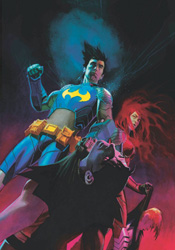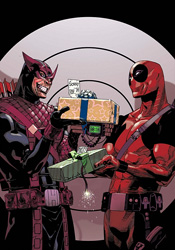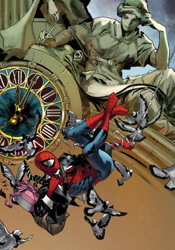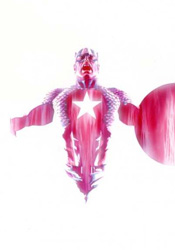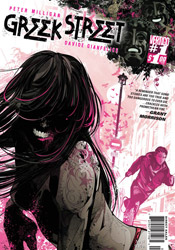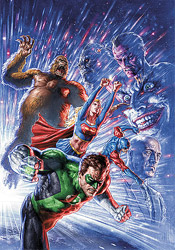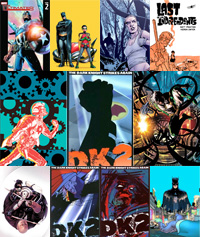A quick glimpse at what else I've been reading this month...
The Ultimates: Book 2 - This was Secret Invasion, done properly, five years before Elektra was revealed to be a Skrull. Quite a bit more action-oriented than the first story arc, and as a result not quite as smart, I'd still call it a top-notch experience. Millar takes a few more chances with the cast and their abilities in this arc, which distances their world a bit from the vivid reality represented in the first storyline. He also adds a few pieces to the supporting cast in Hawkeye, the Black Widow, Quicksilver and the Scarlet Witch. Fortunately, the new faces only serve to compliment what was already a fantastic group of distinct personalities, filling roles that were left vacant during the earlier adventure. I didn't remember there being quite so many punchlines in this collection, which took a bit away from the mystique that had been previously established, but at least it's actually funny when it tries to be. Good stuff, good stuff.
9/10Batman and Robin #1 - A bit of a slow start for the new series, which isn't necessarily a bad thing. Not every story needs to be an unstoppable destruction derby from start to finish. I did find it a bit strange that either the entire issue took place during an overcast afternoon or Frank Quitely doesn't have a thing for long shadows and dark backgrounds. Batman and Robin are so consistently associated with the night that it seems off to catch them going about their business against a well-lit skyline. I liked the rapport between Dick and Damian, with neither side of the new partnership fully trusting the other, and the give and take certainly put a new spin on an old, traditional relationship. I'm not at all sold on the villains yet - they seem skewed and twisted just for the fun of it - but again I suppose that's intended to put a fresh stamp on this classic pair of characters. Did Wayne Tower always have pointy Batman ears on the roof? Isn't that a bit obvious? I found this to be acceptable, not blow-me-away good like the pair's run on
All-Star Superman but also not a complete let-down. I'll give it time to fully develop before I dive into any harsher criticisms.
6/10The Walking Dead #62 - After what happened to the group last month, it's understandable to burn an issue on reactions and recoveries, both emotional and physical. Of course, it wouldn't be
Walking Dead without a random appearance by a stumbling, mumbling gang of zombies, but that's over and done with in a few pages and then it's back to the mourning. Not sure where Kirkman is going with the upcoming "Trackers" storyline, but he's certainly foreshadowed the hell out of it so clearly there's something important about to go down. I keep wishing he'd just get on with it, reaching the end of the issue and deciding that surely next month is the moment the cat gets out of the bag. But then it doesn't, and the process just repeats itself. At least this month the shadowy men lurking in the background have taken some sort of action, so it seems that they're finally ready to make their move. That is, until next issue rolls around and it's more of the same. Still, these are minor complaints and even during a slow month this remains a tip-top series.
8/10Last of the Independents - I'd bought this when it was first released, having been a somewhat regular reader of Matt Fraction's blog at the time, and haven't picked it up again since. I can remember finishing it the first time through in a single sitting, and fortunately enough it's handled the years very nicely. The story is simple enough - an aging low-level mastermind and two buddies aim to hit it big by clearing out a small-town bank, only to find the unexpected: three enormous bags of mafia property sitting in the vault when they arrive. The rest of the developments spiral outward from there. It's a simple heist tale with a trio of complex, well-rounded personalities and no shortage of imaginative explosions or sudden gunfights. Fraction's writing is astonishingly concise and terrifically effective, but the show's really stolen by his artist, Kieron Dwyer. Dwyer brings a fresh face to every character in the drama, whether it's a lead or one of the nameless suits unfortunate enough to step on a land mine after a single panel. The entire issue is presented in a wanted poster-style duotone: brown, white and khaki on a newsprint stock that gives things an extra layer of western authenticity. I felt like I needed to wash my hands after sitting down to read this, and could've sworn I tasted some of the dust that was kicked up during one of its crazier action scenes. Loads of fun, easy to pick up but painfully difficult to set back down again.
9/10Ex Machina #43 - I can't shake the feeling that I'm missing something here, because from all indications each of the major characters are focused on one specific direction and I haven't the foggiest what on Earth it is. Reading this issue was like watching the trials at the end of
Indiana Jones and the Last Crusade without realizing they were after the Holy Grail. Why are they going through all this trouble? What do they expect to find? What could possibly be worth this kind of a risk? Eh... we'll just tell you when they get there, mmmkay? That nothing much of consequence really went down this month only makes things worse. It was just thirty-odd pages of characters gearing up, saying their farewells and getting ready to face, literally, the great unknown. Except they know what it is. Maybe I'll appreciate it more once the series has concluded with issue #50.
6/10The Dark Knight Strikes Again #1 - After a few years on the shelf, I wanted to see if this was still as bad as I remembered it being. Well, as far as the first installment goes... it is. If I dig deep enough, there's plenty of great conceptual work here to get excited about - the Atom's entrapment inside a petri dish, the idea of an artificial President of the United States, the extremes the media has gone to in order to gain an upper hand in the ratings - but it's all tangled up in such a forced, convoluted plot that it's tough to pay attention to the good stuff. Miller's writing is infuriating, he spends half the issue testing to see how much slack the DC editorial staff is willing to give him and to call the other half sloppy does a disservice to the word itself. The plot is all over the place, introducing unnecessary changes on a whim while never really explaining the motivation, and the artwork... fuck, the artwork. It's HORRIBLE. I've admired the risks Miller has taken with his style for literally his entire career. He never stands still, always trying something new. Take a look at his
Daredevil, his
Ronin, his
Sin City; when he's motivated Miller is a genuine renaissance man. He can try anything, take any inspiration to the page, and still come out smelling like roses.
The Dark Knight Returns is his masterwork, a gorgeous blend of frantic linework, meticulous details and careful omissions. Professors could spend entire semesters on the lessons he taught in that mini-series, but in
TDKSB he's utterly lost his mind. With the exception of the aforementioned petri dish scene, in which Miller reverts back to the style he employed on
Ronin, this is inexcusable work. If I were the editor upon whose desk these pages had arrived, I'd have been strongly motivated to reject them, for all the brass balls that kind of move would have required. I know that as a culture, we afford legends a certain degree of lenience out of respect for what's come before, but there's a limit to what I'm willing to accept and this is well, well beyond that. It's just awful, and I fear my memories are correct: the worst is yet to come.
2/10Dark Avengers #6 - I might be able to write the same review for just about every issue of this series. For the moment, at least, more Osborn means more entertainment and this issue provides yet another playground for his personality to fool around with. Of course, the green-shaded voices that keep filling his head are cause for concern, but for now I'll give Bendis the benefit of the doubt. He hasn't gone completely over the top with Norman yet, and the scene he delivers with the fearless leader and Namor this month is good enough to momentarily erase any worries about the future. Deodato could stand to make Norman a bit less of a Tommy Lee Jones clone, but otherwise his artwork is showing continued signs of improvement. He's a bit different than what I'm used to in a high-profile Marvel book, but this is anything but your typical team of superheroes.
8/10Daredevil #119 - Feels like the calm before the storm - there's a lot of talk, double-crossing and maneuvering this month, without a lot of action. Every issue of Brubaker's run has seemed like it's moving to a completely different tempo, which may make for good reading in the trades but it's a bit disorienting when you're following month-to-month. If anything, he knows how to keep me guessing - I haven't known where this arc has been going from word one, and I'm pleased to report that hasn't changed this month. Bru keeps surprising me with the duality of his characters, which means there are very few truly good or evil men and women in this series. Matt's made some serious mistakes recently, and rather than confront them he's chosen to sink back into his work as Daredevil and neglect his personal life. The Kingpin has been through the wringer since his disappearance, and while he's clearly not the same man who took charge of the city years ago, that isn't stopping him from giving the old business another serious shot. Eventually something's got to give, but we've all spent so much time getting to know these individuals that it's going to make quite a thud when one of them falls. It gets pretty dry in parts, but otherwise this is some really complex, fascinating work.
7/10The Dark Knight Strikes Again #2 - Even worse than the first issue. How long did Miller spend on this? One long weekend sounds about right... there's so little effort involved with these illustrations that they almost transcend their own genre and become great comedy. Maybe more disappointing than Frank Miller's own failures in this series are those of his wife and collaborator, Lynn Varley. Throughout the first
Dark Knight, she was an easily-overlooked but essential part of the team. Her colors brought just as much to the scene as Miller's pencils, inks and storytelling, and in an era before computerized colors, she really helped the series to stand out. None of its competitors looked anything like it. Now, a decade and a half later, she's trying her hand at the magic computer box with embarrassing results. Easily fascinated by gradients, Varley pays more attention to blur filters and awkward, pixelated special effects than she does to coloring inside the lines or adding anything to the visuals. Her failures just throw one more shovelful of dirt on the unmarked grave of this awful mini-series. No matter where I look, there's something to furrow my brow and frown about.
1/10The Dark Knight Strikes Again #3 - I'm a little confused about why this is even classified as a Batman book, since the caped crusader quite clearly plays second fiddle to Superman in ever single issue. Even the lead villains, Luthor and Brainiac, are shamelessly pillaged from Clark's Rogues Gallery. Despite being little more than an afterthought in issues 1 and 2, the imposter Joker finally shows his hand with about ten pages left in the third chapter, climaxing in Bruce's one true moment to himself and a surprise revelation that should probably carry more weight than it does. Miller's artwork remains crazily inconsistent in this issue, with some pages showing actual promise and others displaying the same callous lack of interest that damned his first two showings. His writing does show a slight improvement, but Lynn Varley's colors don't enjoy the same fate. This sequel is a disappointment from start to finish, uncomfortable at its best and insulting at its worst. Did I really drop close to thirty bucks on this when it first came out? What a shame...
2/10Batman and Robin #2 - I wasn't so sure about the direction proposed by the first issue, but should've known better. Morrison and Quitely hit the ground running this month and never look over their shoulders. This issue moves quickly, asks more questions than it answers and shows off the inherent difficulties in Dick and Damian's relationship. It's an uncertain time in both characters' lives, and they each seem to feel that the other is holding them back from realizing their own true potential. I didn't really care for the freakshow villainy squad last month, but they're beginning to grow on me, particularly as more of their odd eccentricities are revealed. I love the tiny, campy little nods to the old TV series that Quitely has been working into his artwork so far. The string of S's left behind in the smokey trail of that departing rocket, the "smash" spelt out by the cracks in the wall after a scuffle, they're subtle enough to blend in, but not so much that they go unnoticed. This is starting to be just as much fun as
All-Star Superman.
9/10
